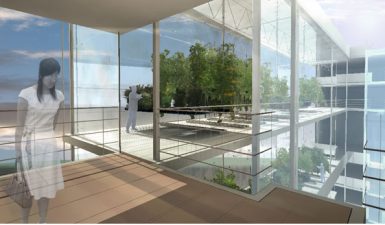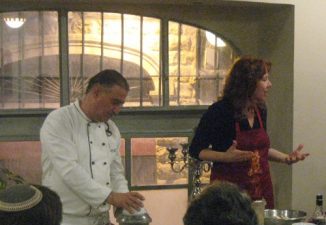 Designed by Hassan Fathy, the Akil Sami House in Egypt is a fairly recent example of earth architecture that is both beautiful and functional.
Designed by Hassan Fathy, the Akil Sami House in Egypt is a fairly recent example of earth architecture that is both beautiful and functional.
If the architecture mentor is successful, his or her student will first absorb and then build upon their lessons until they eventually supersede the original teachings with new knowledge. Certainly this is true of Kelly Hart, a student of the Iranian architect Nader Khalili, who conspired with NASA to create earth architecture that has lunar and space applications. One of the folks behind Earthbag Building, Earth Bag Structures, and a host of other informed eco-building sites, his own legacy is very much grounded on this planet. Hit the jump for a look at our adapted list of Hart’s 13 principles of sustainable architecture.
1. Think Small
The combined problem of natural resource depletion and population growth is so serious that it’s no longer reasonable for anyone to use up more than their fair share of either. Not only that, but there’s something special about creating a home or office that speaks to the specific needs of your particular family. Small homes are more affordable, use fewer resources, have less of an environmental impact, and also require less energy to heat and cool.
2. Heat With the Sun
Speaking of heating, fossil fuels are on the wane but the sun is still going strong. Consult your local green building expert for the best way to orient your home in order to maximize solar gain when appropriate (and reduce it when there’s too much.) Orientation combined with a green building material that absorbs the sun’s energy during the day and then dispatches it slowly at night can drastically reduce your energy requirement.
3. Keep Your Cool
The same principle works for cooling a home, a particular challenge in the Middle East where there is no shortage of long hot days. Passive design, digging into the earth, and insulating a home well will work wonders, as will Islamic design techniques such as the Mashrabiya screen, which beats the heat at the same time as it promotes natural ventilation.
4. Use Renewable Energy
We know this is hard in the Middle East, where solar panels are still quite expensive, but an investment in the short term will pay off in the long run. Plus, who says it’s necessary to buy into the most expensive renewable technology? In Cyprus, Egypt and Israel, lower income people have been using the sun to heat their water for years. Theirs may not be the sexiest roofs in each country, but their energy bills are smaller, and their ability to withstand municipal price and supply fluctuations far greater than grid-dependent folks.
5. Conserve Water
There are as many ways to conserve water in your home as there are reasons to do so – particularly in our dry region. Firm up faucets, harvest rainwater, recycle gray water, take shorter showers, and turn off the tap when brushing your teeth. Also consider planting indigenous plants that don’t require a lot of irrigation, and if you must irrigate, trying using drip irrigation or other modern developments.
6. Use Local Materials
When you’re building a home out of materials harvested in some distant land, they have to travel a long way to make it to your little plot. This creates an unnecessarily high carbon footprint and also reduces the level of control you have over how those materials are harvested. But if you use local materials, as will be the case with Gaza’s 20 new Eco-Schools, your carbon footprint shrinks considerably and benefits your local economy.
7. Use Natural Materials
Natural materials not only have more aesthetic appeal, at least in our view, but it turns out that they are better for our health. A home that is built with a porous natural material such as mud or stone or lime breaths and promotes natural circulation in the home. Anything else creates a terribly unhealthy internal environment. Natural materials also promote daylighting and superior acoustics, whereas all kinds of interventions are required in more artificial surroundings.
8. Save the Forests
Our forests are beautiful and deserve to be protected in their own right. But they also serve important environmental services – including sucking the globe’s carbon. With escalating levels of greenhouse gases in our atmosphere and a bevy of attendant climatic changes, protecting our trees is more important than ever. The average timber home uses 100 trees – and that’s not sustainable at all. Kelly Hart recommends using wood carefully – for decoration or for roofing – and opting for abundant earthen materials to build the rest of the home.
9. Recycle Materials
We belong to a throwaway culture – something the earth’s finite resources simply can’t support. Recycling materials not only gives new life to something discarded or disused, but also provides an opportunity to be creative and resourceful. See how old windows have been given new life is this wonderful design project.
10. Build to Last
We have showcased several earth architecture buildings that have lasted centuries, such as Yemen’s Manhattan and these awesome cave homes in Iran. Despite stringent new building codes, many materials used in contemporary architecture are designed NOT to last so that the supplier can prolong their business opportunities. This makes absolutely no sense. Build to last as much as possible and save the earth while you’re at it.
11. Grow Your Food
Growing food at home improves quality control and increases resilience – both very necessary in our region where food security is poor and where environmental regulations regarding food quality are poorly enforced. We have published 7 agricultural solutions that will save the Middle East. Take a look and be inspired to start growing your own food immediately!
12. Store Your Own Food
This is something we haven’t considered in a long while, but it used to be that most people built pantries into the earth in order to keep their food cool and fresh. As demonstrated in Palestine’s numerous geothermal projects, the earth’s temperature remains constant even as our atmosphere warms and cools. If you use the right building material, you can build a wonderful earthen pantry that will keep most of your food fresh year ’round. Make sure to consult a professional until you get the hang of this.
13. Share Facilities
Finally, Kelly Hart promotes co-housing and eco-villages as a good way to save space and share facilities. He suggests that building common areas (like the Israeli Kibbutzniks have done for years) in addition to private areas in any housing project saves space and promotes social activity. We’d also like to add that a shared community is likely to grow into a more evolved and tolerant community, which promotes all kinds of goodness.
If you are considering building a new home, remember to consult this list to determine whether you have achieved the greatest amount of sustainability for your time and budget constraints.
More on Sustainable Architecture in the Middle East:
Why We Need an Earth Architecture Revolution (VIDEO)
Iranian Architect Nader Khalili Built Earth Architecture Fit For Space
Hassan Fathy is the Middle East’s Father of Sustainable Architecture




It is so encouraging to see that we are going in the right direction with this. I will certainly build my house like this, but would it be possible (and allowed)to build this in thecity? The next step will be dealing with all of the bureaucratic hurdles imposed by local housing legislaturs. I hope one day this can become the “normal” way to live -especially in cities , where population growths are highest. So interesting!
I think the last point is really the key – refiguring our sense of space and community, giving up our own luxurious little walled world for the sake of reducing consumption.
Suppose the size of every building was determined by how much electricity its roof-top solar panels could exclusively generate for the rooms below — no more sky-scrapers?
Nowadays it is great to see that going green has become the in thing in the real estate market, both residential and commercial. What is more important, even some developers are trying really hard to get a green building certificate so they could market their buildings as eco-friendly. That is definitely a way to go.
Thanks Gina, I’m so glad you approve! But all the credit goes to Kelly Hart for dreaming up the suggestions in the first place. I just filled in the blanks 🙂
Thank you for putting all this so clearly and succinctly.
Correct orientation of the building is one that is so often overlooked — there is no reason to have a building face the street! The neighbourhood would be just as harmonious if all the buildings faced the sun.